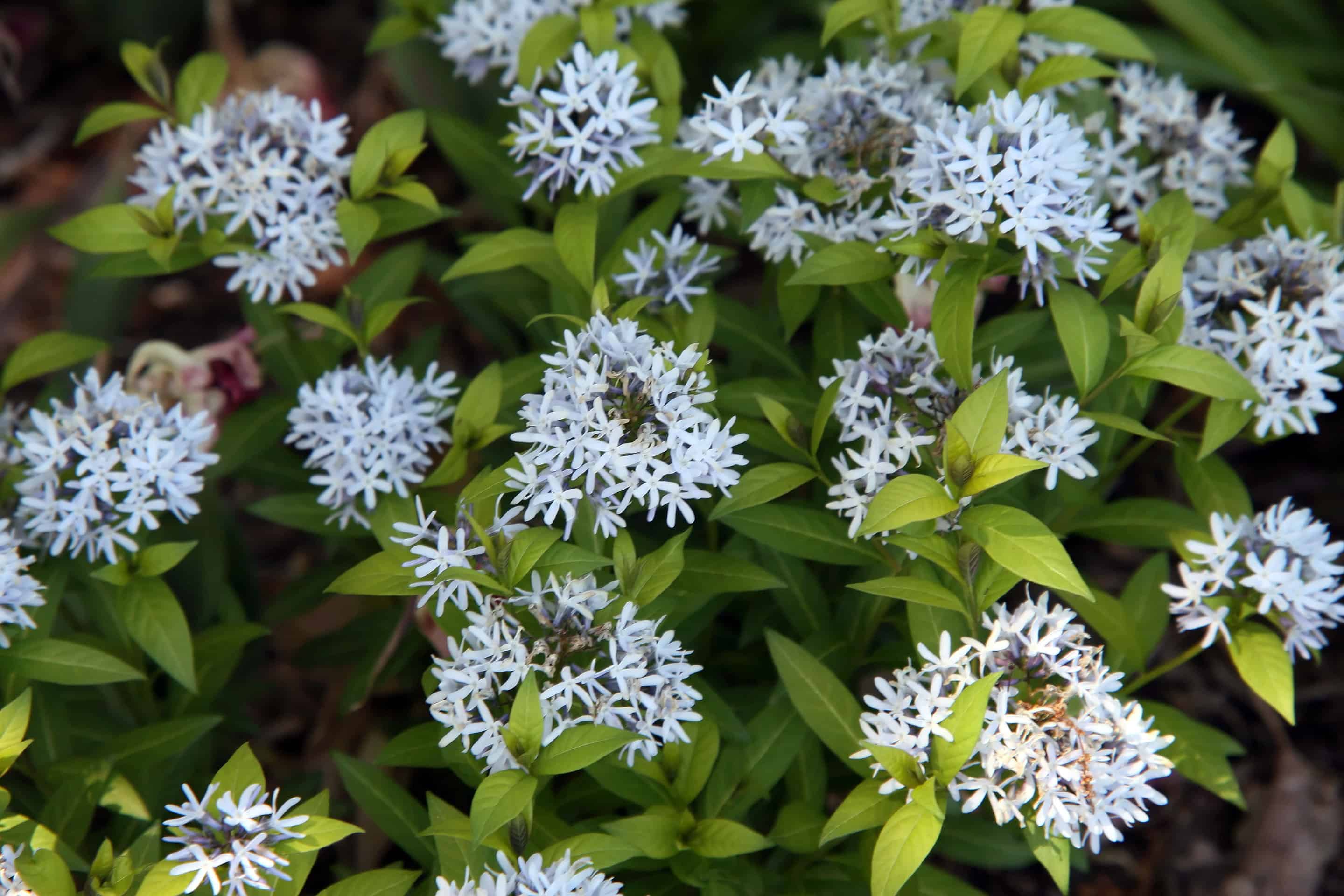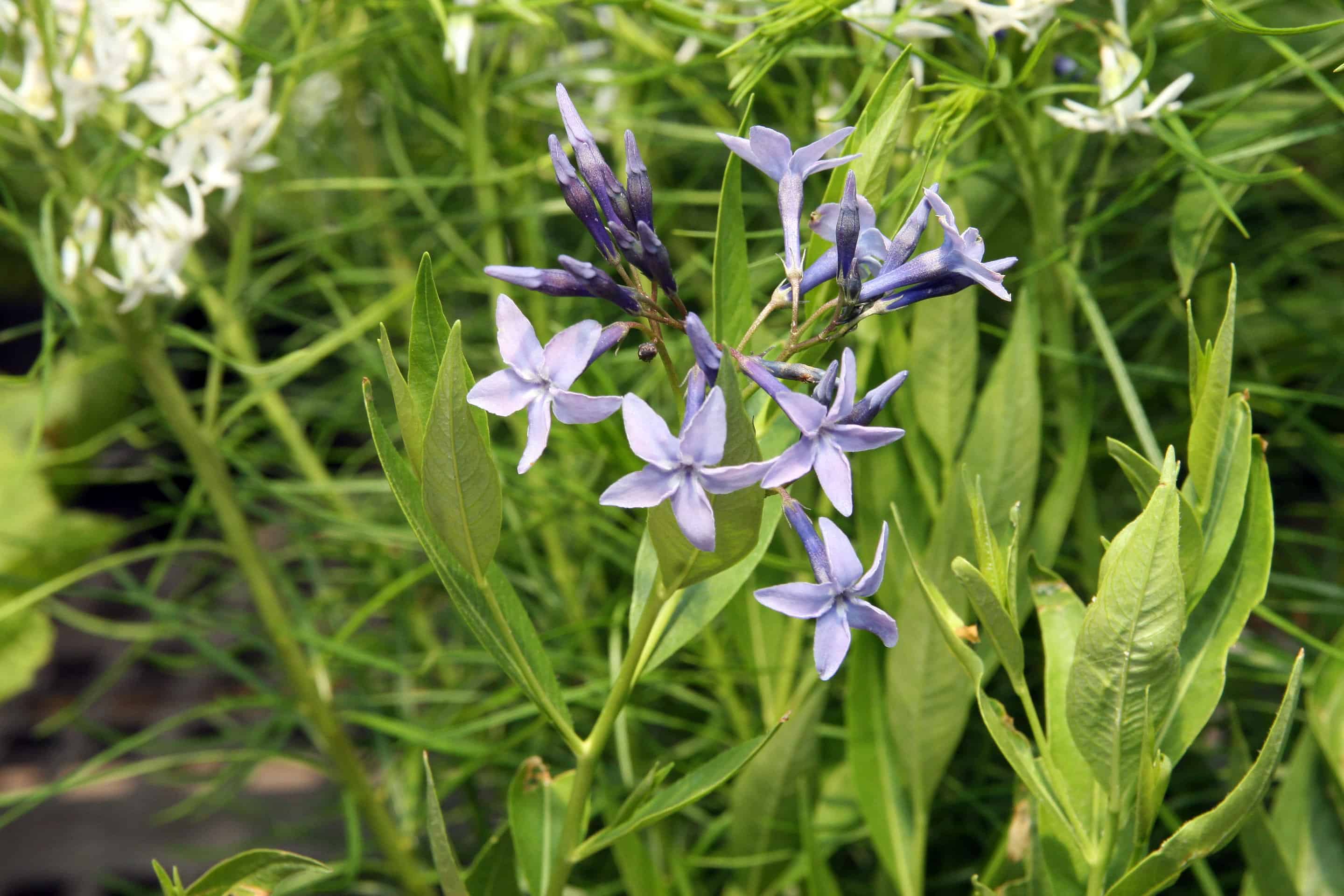No products in the cart.
Table of Contents
Amsonia plants make for a gorgeous color palette in the garden in late spring to early summer, while it displays bright golden yellow hues in fall. So you have a year-round display of vibrant colors in the garden. Today we will look closer at the Amsonia hubrichtii with the common name blue star.
More About Narrow Leaf Blue Star

The Amsonia plants are part of the Apocynaceae or dogbane family with light blue flowers and milky sap. The wildflowers are herbaceous perennial plants and last for years under the right conditions.
The plants grow well in North America, and the Amsonia hubrichtii received a Perennial Plant Association award in 2011. The blooms emerge in early spring, while the blue star flowers only arrive in early summer on 3 feet long stems.
These plants provide excellent ground cover, with their bushy foliage providing shade for your smaller plants. It also makes for perfect fall perennial borders with its golden color. In addition, the blue star attracts butterflies and carpenter bees and is hardy in USDA zones 4-9.
While the star-shaped flowers provide a gorgeous color display, the main attraction of these fall-blooming perennials is their golden yellow display. Some other common names are:
Arkansas Amsonia
Arkansas Bluestar
Narrow Leaf Blue Star
Hubricht’s Blue Star
Arkansas Bluebell
Amsonia Plant Care

The blue star flower thrives in most gardens, so gardening is easier when caring for the blue star flower. The Arkansas star is low maintenance with moist soil in full sun or partial shade. While it can grow large, it does not need to be divided for several years.
Planting Amsonia Hubrichtii
When you buy your Amsonia blue star from a nursery, you might receive them as bare-root plants with up to eight eyes to plant in a gallon container. You can fill the pot with a well-drained potting mix with the bare root crown below the soil surface.
After planting, water the soil well and allow excess water to drain. Allow the soil to dry between watering, and once new leaves emerge, you can apply a water-soluble fertilizer. Alternatively, you can grow Amsonia directly in your garden, but note spacing as the plant spreads wide.
Best Soil For Bluestar Flowers
The blue star flowers need well-drained soil whether grown in the garden or a container. The best soil for your narrow-leaf blue star is a mix of loam, sand, clay, and chalk.
The soil preferably needs to be alkaline, acidic, or neutral soil. Neither does the narrow-leaf blue star enjoy an environment with prolonged drought when not established.
But once established, it can handle short drought sessions.
Lighting: Not Too Much Shade

The perennial plant thrives in partial shade to full sun as it allows your plant to grow healthy. Thus, the Hubricht’s blue star needs at least six hours of direct sunlight and partial shade daily.
We do not recommend growing the Amsonia in too shady conditions as you may not end up with the plant flowering those gorgeous star-shaped flowers in late summer. As it is a herbaceous plant, those needle-like leaves do die back to the ground yearly.
But it returns to life in late spring, early summer, and fall.
Watering Narrow Leaf Blue Star
Your Amsonia plants look fabulous in mass plantings, and even the water schedule is mostly straightforward.
Still, the plant prefers regular watering in the growing season or when very warm with good drainage. Thus, it has an average need for watering but should not be waterlogged as it can still lead to root rot.
So, whether you grow them in a container or on the ground, we recommend the finger test to determine if the soil is moist or not.
Fertilizing Amsonia Plants
When you notice new green leaves emerging in the growing season, you can feed your star flower blue plant with a water-soluble fertilizer in the garden or a container to encourage new foliage growth and flowering.
Temperature and Humidity
Your blue star plant can thrive in different temperatures to humidity levels, making it ideal for most heat zones in the garden. Provided with full sunlight and part shady conditions, it is a happy plant.
The best part is that your plant is deer resistant and attracts hummingbird moths suitable for your garden. In addition, you can overwinter your plants in icy regions by covering them with a frost blanket.
Or you can bring a container-grown Hubricht’s blue star indoors.
Pruning Blue Star
When appropriate, you can prune your Amsonia plants. Trimming down dead foliage helps with new growth and keeps your dogbanes compact. You can even cut them as they make for good cut flowers, as those flowers look great in a floral display.
Even the fall foliage can brighten up your living space.
Another benefit is you need not deadhead flowers, and you can provide additional support with framing on either side of your plants to provide support. Doing this will help when your plants start seeds to keep them in place without the need to remove them.
Propagating Amsonia Hubrichtii
Propagating your Amsonia is best done with the seeds. You can harvest the seed pods and leave them to dry. You can then sow the seed in the fall or overwinter them in a protected area to transplant in spring. All you need to do is cover them with moist soil until it germinates.
Amsonia Varieties
For gardening, you can find several versions of your Amsonia plant, and here are some of our favorites:
Arkansas ‘Blue Ice’

The dogbane flower is a bit shorter yet stockier than most types of Amsonia plants, but it is a hybrid with pale blue flowers.
Eastern Bluestar

It is a standard variety with the name Willow Amsonia or Willowleaf with two different scientific names, Amsonia tabernaemontana, and Amsonia ciliata. The Eastern Bluestar also makes for a great garden display in bloom and fall.
Ozark Bluestar

The Amsonia illustris is a notable outdoor plant with sparkling green leaves giving it the common name shining blue star.
Common Diseases and Pests of The Narrowleaf Blue Star
Now, if you want a plant in the garden that is pest and disease free, it is the Arkansas bluebell. The only concern is that when you do not grow them in full sun, it flops over, and best to cut back after they flower.
Frequently Asked Questions
The plants can do with a cutback after the bloom time completes to prevent them from flopping over or becoming too bushy.
To winterize your Arkansas Amsonia, you can provide them with a frost blanket. For container-grown dogbane plants, you can take your pots indoors.
Yes, the blue flowers look fabulous in a floral arrangement, and the fall color branches look great in a vase during winter.
You can find the Arkansas Amsonia at different local nurseries, but you need not hunt for one, as Plantly has a collection of other blue star plants right here.
Whether you want to buy, sell or simply reach out to other plant enthusiasts, Plantly is the right place to be!


